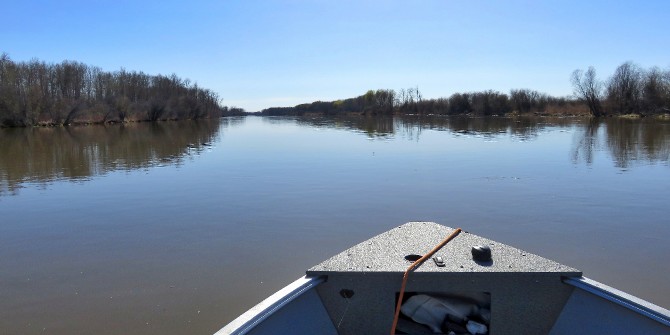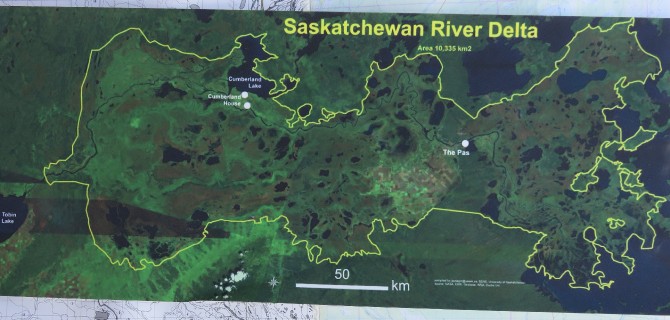SASKATCHEWAN RIVER DELTA, Canada |
||
 |
||
Traveling through the marsh on the Saskatchewan River. |
||
————————————————————————————————— This essay was originally posted to National Geographic's Water Currents blog on July 1, 2017. ————————————————————————————————— Special thanks to Dr. Graham Strickert and Dr. Tim Jardine, researchers at the School of Environment and Sustainability, University of Saskatchewan; Gary and Karen Carriere, Swampy Cree River Delta Advocates. —————————————————————————————————
I am the Saskatchewan River, Kisiskâciwani-sîpiy (in the Swampy Cree dialect, traditionally an oral language), and I have created the largest inland freshwater alluvial delta in North America. It covers approximately 3,860 square miles (10,000 square kilometers), larger than the Everglades National Park in Florida, yet I receive little recognition for this treasure, and almost no protection from the human forces that negatively affect me. My delta is formed from the sediment dropped as I slow down to enter Cumberland Lake. There, my main waterway splits into numerous smaller channels forming dendritic patterns, similar to tree branches or arteries. As I’ve matured over thousands of years, the principal channel has changed course many times. This natural process, known as avulsion, is a characteristic of all rivers, and occurs when one channel is abandoned in favor of a new course, due to erosion caused by fluctuations in discharge. |
||
 |
||
Map of the Saskatchewan River Delta. |
||
![2. Rivière Saskatchewan illustration depicting interweaving channels [ed]](Resources/mapofriverchanne.jpeg) |
||
Rivière Saskatchewan illustration depicting interweaving channels. |
||
![2. Rivière Saskatchewan illustration depicting interweaving channels [ed]](Resources/signbesideroad.jpeg) |
||
Sign beside road entering Cumberland House. |
||
Over eighty percent of my delta consists of vegetated wetlands, and millions of birds pass through it annually. I am both feeding and nesting grounds for hundreds of thousands of waterfowl that migrate to and from the United States, including about 200,000 mallard ducks. Dr. Tim Jardine of the University of Saskatchewan, has analyzed chemical ratios, including stable isotopes, in duck feathers, and has found that my enormous wetland provides a critical stopover for this massive number of ducks, most of which hatch outside the delta, not within it. |
||
![2. Rivière Saskatchewan illustration depicting interweaving channels [ed]](Resources/birds1.jpeg) |
![2. Rivière Saskatchewan illustration depicting interweaving channels [ed]](Resources/phragmitereedbed.jpeg) |
|||
Inhabiting a small island and vying for space are cormorants, pelicans, and sea gulls. |
Phragmite reed beds. |
|||
My entire ecosystem is threatened, and has been drastically disrupted by several dams, including the E.B. Campbell Dam, built in 1962. As with most of my river cousins around the world, dams have altered my natural flow regime. The transport of sediment has all but stopped, and my wetlands are being starved of nutrients. Man-made hydro-electric structures also prevent seasonal floods, thereby speeding up what would normally be slow change. Cumberland Lake used to be twenty-two feet deep. Now, it is only about three feet deep, and my wonderful delta is shrinking along with habitat for countless species. At the same time, human demand for my water is increasing, for household purposes, for agricultural irrigation, and for industrial needs, further reducing flow to the marsh. My entire system is out of balance.
Water quality is an issue for me, too. In the past, mercury was one of the most significant risks, especially to the fish who call me home. Inputs of mercury from a bleach factory, and the filling of reservoirs over what was previously pasture, and agricultural land, introduced mercury into my system. Fortunately, scientists who monitor my delta today find that this problem has subsided, but many of the upland agricultural areas are still draining pesticides and other toxins into my already stressed body. |
||
![2. Rivière Saskatchewan illustration depicting interweaving channels [ed]](Resources/collectingwaters.jpeg) |
![2. Rivière Saskatchewan illustration depicting interweaving channels [ed]](Resources/ebcampbelldam.jpeg) |
|||
Collecting water samples to test for mercury. |
E.B. Campbell Dam. |
|||
Yet another threat to my wetlands is a prolific invasive perennial grass, Phragmites australis, which lowers biodiversity, and secretes gallic acid that is toxic to native plants. Because Phragmites monoculture reed beds spread across vast distances, their physical size above and below ground chokes out healthy plants. Animals don’t like to eat it, and so it has mostly negative effects on a marsh ecosystem. One way to control it is through burning, something that was regularly done by local trappers on my banks for generations. Currently, this practice is discouraged by provincial government agencies that see any fire as a threat to nearby forests.
Even though I am the third largest river in Canada, and I pass through many populated areas, there is one small village that I’m especially fond of near the end of my journey. Cumberland House is home to both the Swampy Cree and the Métis (who trace their ancestry to First Nations peoples and European settlers, particularly early fur traders who intermarried with the aboriginal inhabitants of the region). The Cumberland House Cree Nation has a population of approximately 820 members living “on-reserve,” and another 570 or so members who live “off-reserve.” The nearby Northern Village of Cumberland House is largely a Métis community of about 770 people. Together these indigenous people and their ancestors have looked after me for as long as I can remember.
The original Cumberland House dates to 1774, and is the oldest permanent settlement in Western Canada. In the Swampy Cree dialect, its name is Waskahikanihk, which means “at the house,” for it was an important fur-trading post and a depot for pemmican, a staple food of the voyageurs who paddled my waters in canoes laden with furs and trade-goods. Pemmican (pimîhkân in Cree) is a nutritious mixture of protein and fat made from whatever ingredients were available including bison, deer, moose, or elk mixed with fruits such as Saskatoon berries and cranberries. A non-perishable and portable food supply was a necessity, for it took about forty days of paddling to get to the Hudson’s Bay Company base at York Factory, and almost five months to reach Montreal.
It makes me sad that as the productivity of my great marsh declines, many of the indigenous cultural ways of surviving also decline. Fortunately, there are people fighting for my existence. Among them are the Swampy Cree voices of two strong advocates, Gary and Karen Carriere, who run a hand-built wooden lodge on my banks to host hunters in the fall months, and provide shelter, meals, and a living laboratory for artists and scientists from around the world who visit throughout the year. One of these scientists, Dr. Graham Strickert, of the University of Saskatchewan, has been here many times working with interdisciplinary colleagues, most recently a university class of artists. As he sat on a dock at Cumberland House, I heard him say, “Science can move the mind, but art can move the heart.” |
||
![2. Rivière Saskatchewan illustration depicting interweaving channels [ed]](Resources/karenandgarycarr.jpeg) |
||
Karen and Gary Carriere at breakfast in their hand-built Mistik Lodge. |
||
They say that Karen Carriere cooks a yummy, tender walleye caught fresh from deep in my interior, and breaded with crushed cornflakes, lemon, pepper, and eggs. But another mainstay of the Cree culture here, sturgeon, are far fewer in number than they were historically. Passionately, Gary Carriere explains to anyone who will listen how the entire food chain is affected by the changes in my marsh. He bemoans the fact that since the delta habitat is shrinking, so is the number of mammals. Gary used to make a steady income by trapping muskrat, but now they have all but disappeared from my shores. He takes his motor boat out along my spine, and acknowledges that he owes his life to my delta, where he was raised. Gary is always trying to figure out ways to give back, and he asks poignant questions: While the government will protect an endangered species, what about the endangered indigenous cultures who rely on this wetland for their survival? He says he would like to see traditional indigenous knowledge added to school curriculums, because passing along native wisdom about me and the animals who rely on my water, is one way to preserve this irreplaceable region.
Yes, I am fortunate to have the remaining beaver who live here building lodges on my shores, slapping their tails as a warning to kinfolk. Otters bob in and out of my current, and almost daily I see moose, woodland caribou, elk, deer, bear, badger, skunk, fox, martin, squirrel, weasel, wolverine, and coyote, although at greatly reduced populations from a few decades ago. Oh, I am a happy river, to be able to co-habit with such a rich variety of creatures! |
||
![2. Rivière Saskatchewan illustration depicting interweaving channels [ed]](Resources/satellitedishato.jpeg) |
||
Satellite dish atop a beaver lodge. |
||
There are light-hearted curiosities, such as the satellite dish sitting atop one beaver lodge, ready to help receive far-away messages. And there are festivals, dances, and canoe races upon my skin. Another advantage of being a river this far north is that I get to witness the aurora borealis dancing across the night sky, a ribbon of lights arcing from horizon to horizon mimicking my own shape – an undulating, luminescent river in the sky.
Once, I heard a song about me. The lyrics of “The River,” by Coco Love Alcorn say: Water heal my body, Water heal my soul, When I go down, down to the water, By the water I feel whole.
Thank goodness, there are people who can relate to these words. |
||
next page: Narmada River >
< previous page: Chaobai River




































